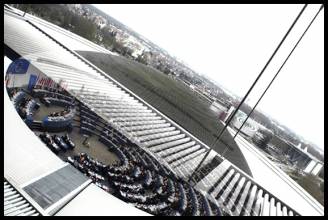
Passage of a new regulation on Galileo sets the stage for the next phase of the €3.4-billion satellite navigation system’s development under a public procurement but leaves many details to be worked out among the key players: the European Commission (EC), the European Council, the European Parliament, and the European Space Agency (ESA).
Meeting in Strasbourg, France, the parliament adopted the measure on April 22 with 607 votes in favor, 36 votes against, and 8 abstentions.
“Things are looking up, finally, for the European GNSS programs,” Paul Verhoef, head of the Galileo unit in the EC’s Directorate-General for Transport and Energy, told an April 23 plenary session of the European Navigation Conference 2008 in Toulouse, France.
Passage of a new regulation on Galileo sets the stage for the next phase of the €3.4-billion satellite navigation system’s development under a public procurement but leaves many details to be worked out among the key players: the European Commission (EC), the European Council, the European Parliament, and the European Space Agency (ESA).
Meeting in Strasbourg, France, the parliament adopted the measure on April 22 with 607 votes in favor, 36 votes against, and 8 abstentions.
“Things are looking up, finally, for the European GNSS programs,” Paul Verhoef, head of the Galileo unit in the EC’s Directorate-General for Transport and Energy, told an April 23 plenary session of the European Navigation Conference 2008 in Toulouse, France.
The new Galileo regulation puts the EC firmly in control of program management, adds a post-deployment “exploitation phase” to the plan, provides broad outlines of responsibilities among European organizations, but leaves many aspects subject to further refinement.
These details include establishing the legal framework for operation of the system, regulatory measures, intellectual property rights (IPR), and liability regimes for the European Geostationary Navigation Overlay Service (EGNOS) and Galileo itself.
The EC must also complete a delegation agreement with ESA to serve as the prime contractor, outlining responsibilities and guidelines for the procurement process.
The regulation targets the 2008–2013 time frame for completion of the deployment phase of Galileo, and Verhoef acknowledged that there is “a lot of pressure to stick to the timetable and budget.” However, the realities of developing a satellite navigation system are substantial, he added, “And we cannot overfly those realities as if they don’t exist.”
Verhoef said the program has to complete the procurement process before a more solid schedule can be determined, because the contracts with vendors will have a real timeline for commitment of deliverables.
Finalizing a Galileo Signal in Space Interface Control Document (SIS ICD) remains a priority so that private companies can begin designing and selling Galileo-capable equipment. The size and nature of non-European companies’ participation in the contracts to build the system also must be worked out in practical terms.
Other unresolved issues include the role of the European GNSS Supervisory Authority (GSA) in regards to EGNOS and ESA, as well as technical matters, including Galileo-related R&D projects under the 7th Framework Program (7FP).
The amount of money available for those projects also needs to be determined, given the new deployment plan’s reprogramming of $400 million from the 7FP budget.
Lastly, program leaders must decide on the process and guidelines for contracting with a system operator after a fully operational capability (FOC) is achieved for Galileo.
The Galileo legislation establishes a reorganized structure for deploying the GNSS system and managing the program. It confirms the previously established guidelines for the procurement process that will start in mid-June, with the EC as the program manager and ESA as the design authority that is also responsible for getting bids and letting contracts.
Program leaders hope to have selected vendors and gained signatures on contracts by late this year or early 2009. “ESA will start the procurement, but will not be able to sign contracts until other agreements worked out,” Verhoef said. “These negotiations will be done in parallel with the procurement process.” Verhoef says he hopes that the program can gain six to nine months by following this parallel approach.
The outlines of the regulation had been agreed to in advance during an “informal meeting” among representatives on the council, commission, and parliament earlier this year. That agreement followed approval in late January of a proposal by Parliament’s Industry, Research, and Energy (ITRE) Committee to abolish the GSA and turn responsibility for ensuring the Galileo system’s security requirements over to a new Committee on European GNSS Programs.
“Parliament was rather badly surprised by our announcement last year that the PPP negotiations were ending,” Verhoef said in Toulouse. “They felt they needed better insight into the progress of the program.”
As agreed upon by the three organizations, the regulation sets up a new entity, the Galileo Inter-institutional Panel (GIP), which will be composed of three representatives each of the council and parliament and one representative from the EC. The GIP will monitor the implementation of the GNSS program, the international agreements with third countries, and the preparation of the satellite navigation markets.
The GSA, which would have had a more central role as overseer of a once-envisioned public-private partnership (PPP) to deploy and operate Galileo, will retain a board composed of representatives from the 25 EU member-states and continue as a separate agency but under the direction of the EC.
Under the new regulation, the GSA will now monitor the implementation of security procedures and perform system security audits, “[r]especting the Commission’s role as manager of the programmes and in accordance with guidelines issued by the Commission.”
Ultimate responsibility for management of the security program remains with the EC, which plans on establishing a GNSS Security Board chaired by the commission and composed of security experts with representatives from each member state.
The GSA will be responsible for establishing and operating the new Galileo security center and also will “contribute to the preparation of the commercialisation of the systems with a view to smooth functioning, seamless service provision and high market penetration.”
The regulation also enables the EC to assign other tasks to the agency, “in particular the promotion of applications and services and ensuring the certification of the components of the systems.”
The full text of the regulation can be found at the parliament’s website.
Finishing the Galileo Signal Specification
Officials acknowledge that they need to finalize the Galileo SIS ICD as soon as possible, especially now that the GIOVE-B satellite is in orbit broadcasting new signals, including the multiplex BOC (MBOC) designed for civil use. Verhoef told Inside GNSS that he would like to have the issue resolved by the ION GNSS 2008 conference in September, where he expects to face a lot of questions from GNSS equipment designers and manufacturers.
The issue is complicated, however, by the prohibition on commercial use of the current provisional ICD as well as the question of possible fees that a post-FOC Galileo system operator might want to collect for services or from GNSS equipment manufacturers. One option, Verhoef says, would be to issue free licenses to manufacturers for a limited term. Another would be to resolve the issue in advance and implement those terms in the course of negotiating a concession contract with an eventual Galileo operator.
Manufacturers are pressing for a resolution of the problem before investing in receiver developments that might be wasted if the ICD changes, especially those companies planning on building equipment based on application specific integrated circuits (ASICs) and even field programmable gate arrays (FPGAs).
Although a number of receiver manufacturers have announced Galileo-ready equipment, those generally only involved the design of the receiver front-ends — antennas and RF integrated circuits that can process the wider bandwidth of Galileo (and future GPS). The digital signal processing (DSP) portion of the receiver is what really requires the certain specifications of a final ICD, although manufacturers working with software defined radios — also known as software receivers — have more flexibility in altering their products to accommodate changes.
Gard Ueland, president of the Galileo Services association of “downstream” manufacturers, told Inside GNSS that industry wants to have the Galileo infrastructure in place as soon as possible but would also like to see funds go into R&D projects for early demonstrations of Galileo applications.
GSA and the Road Ahead
The fate of the GSA’s staff and the budget for FP7 R&D projects also remains up in the air.
The plan that transitioned the Galileo acquisition from a PPP process required an additional €2.4 billion in public funds. €400 million of that amount was designated as coming from the €50 billion 7th Framework Program budget of European capital investment during 2007–2013.
The GSA had been allocated €350 million in 7FP funds for GNSS-related technical R&D projects. How much of that amount might be taken back to make up the €400 million remains to be determined.
About €40 million was allocated for the GSA’s first call for projects last year, and another €40 million has been designated for a second call this year, according to Pedro Pedreira, GSA’s executive director.
Typically, only half of a framework program budget ends up being spent in the original categorical allocations, with the remainder being reprogrammed as a sort of European Community contingency fund. Verhoef says the issue will be revisited during the 7FP mid-term review in 2010.
As for GSA staff, the EC is considering whether to move some of the agency’s technical personnel directly into its Galileo unit. Pedreira told Inside GNSS that he wants to ensure “stability” for current GSA staff and hopes to have a revised work plan clarified with the EC by the end of June, and a 2009 work plan approved by the GSA board by the end of September.
The new regulation calls for preparations for an exploitation phase comprising infrastructure management, maintenance, “constant improvement,” and replenishment of the system, as well as certification and standardization operations.
The GSA has been working since last July on a concept for post-FOC operations and has come up with what Pedreira characterized as a “very exciting, innovative” proposal that he believes will “meet the expectations of member states.”
“We are really talking about the transfer of risks,” Pedreira said, an issue that ultimately stymied the original PPP effort. “How would the system operate within the EU legal framework?”
But GSA needs to “sell” the EC on the concept on the concept and, in turn, the EC would have to choose the time to present any proposal to the council. In any case, Pedreira added, there’s no rush for a new operations PPP, which would be difficult to conclude at this point and probably cost more. In the meantime, the program is too busy figuring out work share and procurement contracts.
But That’s Not All
As if these tasks were not enough, other issues remain to be addressed by Galileo program leaders.
Another round of talks is taking place this week in Brussels with Chinese representatives regarding the proposal to place a portion of the Compass (Beidou) signals on the same frequency planned for Galileo’s public regulated service (PRS).
It’s much the same situation as arose a few years ago when Europe originally proposed to overlay its L1 open service signals on the new GPS military (M-code) signal. That potential conflict was eventually resolved in the course of negotiating the 2004 Galileo/GPS cooperation agreement between the United States and the European Union.
“We need to make sure we have the same idea of the problem,” Verhoef told a press conference during the ENC 2008. “As with all engineering, you spend half the time identifying the problem and the other half solving it.
“We have particular problems [with the Compass frequency plan] that we’re not sure the Chinese are aware of,” he added.
The Chinese delegation included Liao Xiaohan, deputy director of High & New Technology Development and Industry for the Ministry of Science and Industry, who spoke at the ENC 2008 conference. Other members were Ran Chengqi, deputy director of the China Satellite Navigation Project Center (CSNPC), and Yang Qiangwen, CSNPC senior engineer.
The new regulation also appears to try to head off any further complications arising from Spain’s desire to upgrade its safety-of-life center to a fully qualified Galileo satellite control center equivalent to those planned in Oberpfaffenhofen, German, and Fucino, Italy. Under the regulation, the program would accept the creation of such a facility and its inclusion in the system’s ground infrastructure as long as no additional cost fell on the Galileo and EGNOS program budgets for the 2007–2013 period.
Meanwhile, non-European companies — particularly U.S. aerospace firms — are pressing for clarification of the level of their involvement in the program, which will follow EU rules, not those of ESA that guarantee a “geographic” award of contracts to companies based on their national governments’ financial contribution to a program.
Considering the experience of past European space programs, “a substantial amount of American components will be flown on the system,” Verhoef said.
The new procurement plan seems to relegate non-European companies to subcontract status. But some companies would like to be able to compete for the lead contracts for the Galileo satellites, for instance.
Because the procurement guidelines limit large companies to only bidding on two of six Galileo “work packages,” some question remains as to whether at least two competitors will show up to go after the lead spacecraft contract. EADS Astrium is expected to compete, as is OHB Technologies (whether or not partnered with Surrey Satellite Technology Ltd., which EADS is in the process of acquiring).
The regulation encourages dual-sourcing, but Verhoef told the press conference, “We’re not going to wait for three or four years to get somebody who’s able to bid.”






